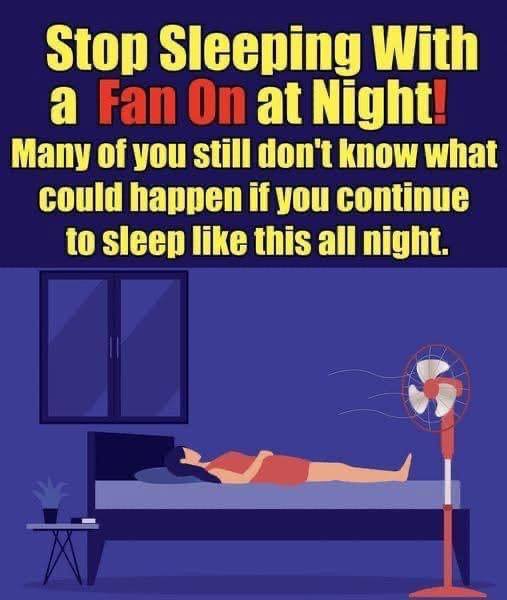Many people rely on fans at night to help them fall asleep, especially during warmer months when maintaining a comfortable sleeping environment can be challenging. While fans offer a convenient way to improve airflow and create a soothing white noise effect, they might not always be the best choice for promoting quality sleep. In fact, using a fan at night can sometimes disrupt sleep and create unintended discomfort, particularly if certain conditions aren’t properly managed.

Experts agree that room temperature plays a critical role in achieving restful sleep. The ideal sleeping temperature is typically between 60 and 67°F (15 to 19°C). This range supports the body’s natural cooling process, which helps facilitate melatonin production—a hormone that regulates sleep. When the temperature rises above or falls below this range, it can interfere with the body’s ability to reach and maintain deep sleep stages. Fans, while effective at circulating air, don’t actually lower the room temperature. Instead, they create a breeze that may provide a temporary cooling effect but often fail to address the root cause of discomfort caused by heat.
One issue with fans is their potential to create overly cold conditions if left running all night. If the fan is blowing directly on you, it can cause your body temperature to drop too much, leading to discomfort or even muscle stiffness in the morning. For those who are particularly sensitive to temperature fluctuations, this constant breeze can result in disrupted sleep patterns or frequent waking throughout the night. Additionally, exposure to direct airflow for hours can lead to dryness in your skin, eyes, and nasal passages, causing irritation and discomfort.
Another downside of relying on a fan for sleep is the potential impact on allergies. Fans can circulate dust, pollen, pet dander, and other allergens that have settled on surfaces in your room. As the air moves around, these particles can become airborne, increasing the likelihood of respiratory irritation or allergy symptoms. For individuals with asthma or seasonal allergies, this can mean waking up congested, sneezing, or experiencing itchy eyes. Regular cleaning of both the fan and the surrounding area can help minimize this issue, but it remains a concern for many.
Noise is another factor to consider when using a fan at night. While some people find the gentle hum of a fan relaxing, others may find it distracting or irritating. Inconsistent fan noises, such as sudden rattling or mechanical whirring, can easily disrupt sleep cycles. Even those who typically enjoy white noise may struggle if the fan is too loud or produces an irregular sound pattern.
Instead of relying on a fan for nighttime comfort, there are alternative methods to create a sleep-friendly environment. First, focus on using breathable bedding and lightweight sleepwear made from natural materials like cotton or bamboo. These fabrics allow air to circulate more effectively around your body, preventing overheating and ensuring a more comfortable sleep.
Investing in a cooling mattress or mattress topper can also make a significant difference. Many modern mattresses are designed with advanced materials that help regulate temperature and wick away moisture. These products offer a more consistent cooling effect compared to fans, without causing direct airflow discomfort.
Humidifiers and white noise machines are also excellent alternatives to fans. A humidifier can add moisture to the air, reducing dryness in your skin, eyes, and throat. This can be particularly helpful in dry climates or during winter months when indoor heating can sap moisture from the air. White noise machines, on the other hand, provide a steady and calming background sound that masks disruptive noises without the physical effects of a fan.
In addition, maintaining a consistent bedtime routine and optimizing your sleep environment can go a long way in improving sleep quality. Keep your room dark with blackout curtains, eliminate unnecessary light from electronics, and minimize noise disruptions. If temperature control remains an issue, consider investing in an air conditioning unit with a programmable thermostat to keep the room consistently cool throughout the night.
Ultimately, while fans can be a quick and inexpensive way to address heat-related discomfort, they are not always the most effective or healthiest solution for improving sleep quality. The key is to create a balanced sleeping environment that supports your body’s natural sleep processes without introducing new factors that could cause disruption. By focusing on breathable bedding, temperature-regulating sleep products, and thoughtful environmental adjustments, you can enjoy more restful and uninterrupted sleep.
In conclusion, while fans might seem like an easy solution for nighttime cooling, they come with potential drawbacks that shouldn’t be overlooked. From creating overly cold conditions and stirring up allergens to causing noise disruptions and dryness, fans aren’t always the ideal choice for everyone. Instead, prioritizing breathable materials, proper ventilation, and tools like white noise machines or cooling mattresses can provide a more sustainable and effective approach to achieving high-quality sleep. By paying attention to these factors, you can set yourself up for a night of deep, restorative rest and wake up feeling refreshed and ready to face the day.





